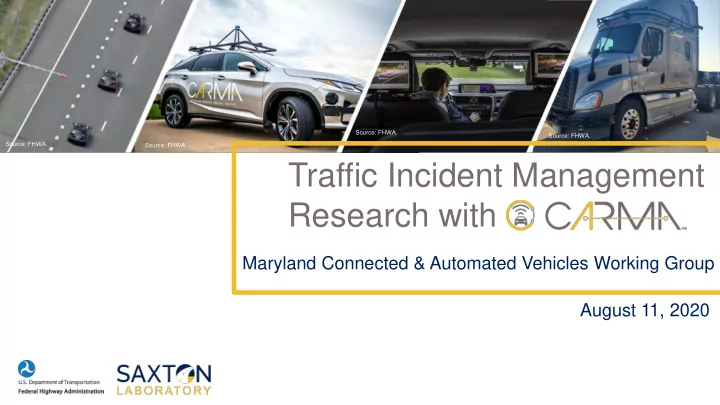

SM Source: FHWA. Source: FHWA. Source: FHWA. Source: FHWA. Traffic Incident Management Research with Maryland Connected & Automated Vehicles Working Group August 11, 2020
SM What is the CARMA Program? The FHWA’s initiative focused on improving the transportation system by leveraging emerging SM SM automated driving technology and vehicle-to-everything (V2X) technology to enable increased safety and operational performance in moving people and goods. 2 Source: FHWA
SM SM Cooperative Driving Automation Source: FHWA Cooperative Driving Automation (CDA): Automation that uses machine-to-machine (M2M) communication to enable cooperation among two or more entities with capable communications technology and is intended to facilitate the safer, more efficient movement of road users, including enhancing performance of the dynamic driving task (DDT) for a vehicle with driving automation J3216* feature(s) engaged. Publicly released May 2020. *SAE International. SAE J3216: Taxonomy and Definitions for Terms Related to Cooperative Driving Automation for On-Road Motor Vehicles. SAE International. W arrendale, PA, 2020. https://www.sae.org/standards/content/j3216_202005/. Last accessed: July 2020. 3
An automated vehicle (AV) sees this… SM How can CDA help? Leverages information from infrastructure and all connected roadway users to improve safety and mobility. For example: ▪ Enhanced sensing. ▪ Intersection optimization. ▪ Congestion mitigation: • Work zones. • Traffic incidents. • Weather. 4 Source: FHWA.
How do you detect the objects you can’t see? SM How can CDA help? Leverages information from infrastructure and all connected roadway users to improve safety and mobility. For example: ▪ Enhanced sensing. ▪ Intersection optimization. ▪ Congestion mitigation: • Work zones. • Traffic incidents. First • Weather. Responder 5 Source: FHWA.
Can you use sensor data from other vehicles? SM How can CDA help? Leverages information from infrastructure and all connected roadway users to improve safety and mobility. For example: ▪ Enhanced sensing. ▪ Intersection optimization. ▪ Congestion mitigation: • Work zones. • Traffic incidents. First • Weather. Responder 6 Source: FHWA.
Public transit vehicles could also participate in SM CDA through shared perception. How can CDA help? Leverages information from infrastructure and all connected roadway users to improve safety and mobility. For example: ▪ Enhanced sensing. ▪ Intersection optimization. ▪ Congestion mitigation: • Work zones. • Traffic incidents. First • Weather. Responder 7 Source: FHWA.
What about infrastructure? SM How can CDA help? Leverages information from infrastructure and all connected roadway users to improve safety and mobility. For example: ▪ Enhanced sensing. ▪ Intersection optimization. ▪ Congestion mitigation: • Work zones. • Traffic incidents. First • Weather. Responder 8 Source: FHWA.
CARMA Ecosystem A network of open source software (OSS) and support services focusing on how infrastructure can move SM SM traffic more efficiently by advancing Transportation Systems Management and Operations (TSMO) strategies. 9 Source: FHWA.
SM A E H J B F I K CARMA Ecosystem C G D A H E J B G D F K I C Source: FHWA.
Ecosystem: Use Cases SM SM Recurring traffic congestion use cases Nonrecurring traffic congestion use Commercial Motor Vehicle (CMV) and on freeways and arterials. cases on freeways and arterials. port use cases. ▪ Port Drayage. ▪ ▪ Work Zones. Congestion. ▪ CMV. ▪ ▪ Transit. Weather. ▪ Truck Platooning. ▪ ▪ Traffic Signals. Traffic Incident Management (TIM). Source: FHWA. 11
Ecosystem: Research Tracks SM SM Recurring traffic congestion use cases Nonrecurring traffic congestion use Commercial Motor Vehicle (CMV) and on freeways and arterials. cases on freeways and arterials. port use cases. ▪ Port Drayage. ▪ ▪ Work Zones. Congestion. ▪ CMV. ▪ ▪ Weather. Transit. ▪ Truck Platooning. ▪ ▪ Traffic Signals. Traffic Incident Management (TIM). Source: FHWA. 12
SM SM Disclaimer Disclaimer The U.S. Government does not endorse products or manufacturers. Trademarks or manufacturers’ names appear in this presentation only because they are considered essential to the objective of the presentation. They are included for informational purposes only and are not intended to reflect a preference, approval, or endorsement of any one product or entity. 13
Contact Us! Pavle Bujanović CARMA TIM Technical Lead pavle.bujanovic@dot.gov Jim Austrich TIM Program Manager james.austrich@dot.gov Taylor Lochrane CARMA Program Manager taylor.lochrane@dot.gov Source: FHWA
Recommend
More recommend